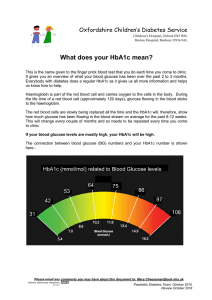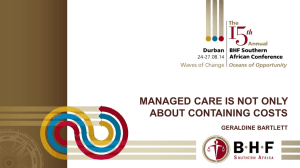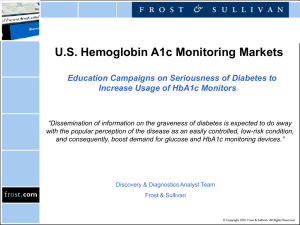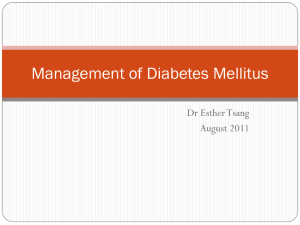Relationship between HbA1C to 2hour post glucose load as a... for Type 2 Diabetes Mellitus
advertisement
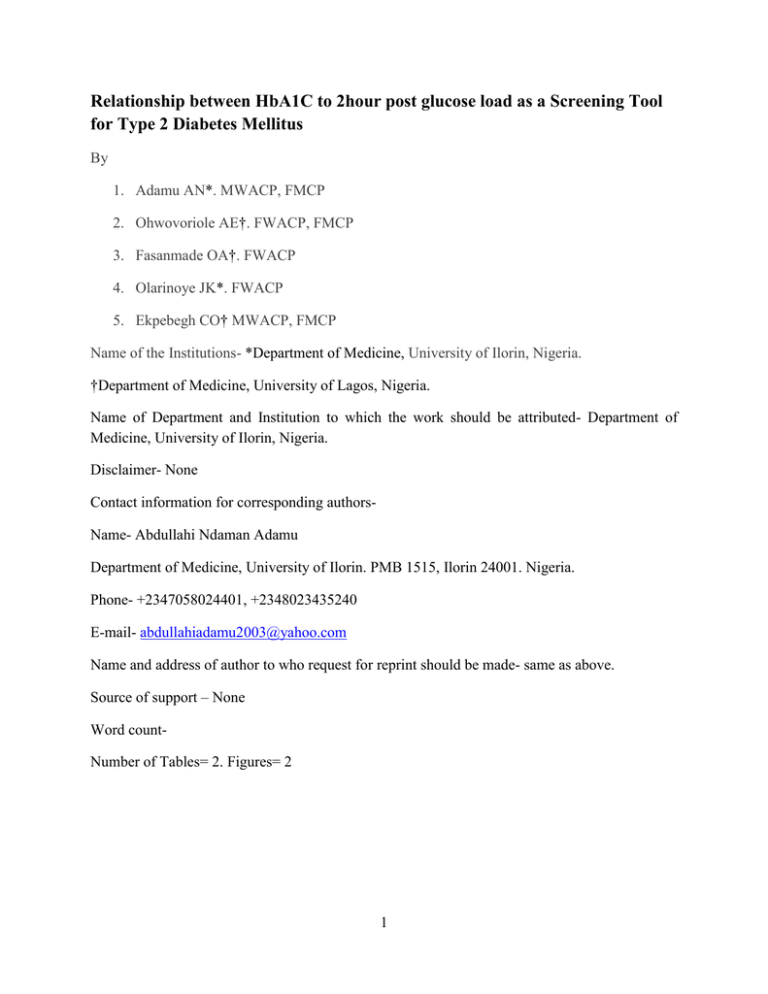
Relationship between HbA1C to 2hour post glucose load as a Screening Tool
for Type 2 Diabetes Mellitus
By
1. Adamu AN*. MWACP, FMCP
2. Ohwovoriole AE†. FWACP, FMCP
3. Fasanmade OA†. FWACP
4. Olarinoye JK*. FWACP
5. Ekpebegh CO† MWACP, FMCP
Name of the Institutions- *Department of Medicine, University of Ilorin, Nigeria.
†Department of Medicine, University of Lagos, Nigeria.
Name of Department and Institution to which the work should be attributed- Department of
Medicine, University of Ilorin, Nigeria.
Disclaimer- None
Contact information for corresponding authorsName- Abdullahi Ndaman Adamu
Department of Medicine, University of Ilorin. PMB 1515, Ilorin 24001. Nigeria.
Phone- +2347058024401, +2348023435240
E-mail- abdullahiadamu2003@yahoo.com
Name and address of author to who request for reprint should be made- same as above.
Source of support – None
Word countNumber of Tables= 2. Figures= 2
1
Conflict of Interest Notification
There is no conflict of interest of whatever form in conception to final execution of this article.
2
ABSTRACT.
Background- There is paucity of existing studies on use of HbA1c as a screening tool for type 2 diabetes among
blacks.
Objective- to evaluate the performance of HbA1c as a screening tool for type 2 diabetes among black people with
systemic hypertension.
Methodology- Two-hundred and seven subjects attending the out-patient department of Lagos University Teaching
Hospital were recruited, out of which 131 of the subjects had OGTT done, 2hour post glucose load plasma glucose
assay was used as a gold standard for the diagnosis . Using systemic sampling of one out of every four, thirty three
of the subjects had HbA1c assayed. Two of the assay revealed error report and were thus excluded from the analysis.
The data was analysed using SPSS 11. Glycated haemoglobin of <6.1% was considered to be negative while
glycated haemoglobin of ≥6.1 was considered to be positive for the screening. Two hour plasma glucose of
<11.1mmol/l(200mg/dl) was considered to be negative while ≥11.1mmol/l(200mg/dl) was considered to be positive
for the diagnostic test. A 2x2 table was made to calculate specificity, sensitivity, positive predictive value, negative
predictive value, efficiency of the test and prevalence of the disease using HbA1c. Pearson correlation, bivariate and
Receiver Operative Characteristic Curve was also plotted.
Results- The mean age of the subjects that had HbA1c assay was 54.26±6.6years. The subjects were made up of
25(80.6%) females and 6(18.4%) males. Mean HbA1Cwas 6.6% and mean 2hour plasma glucose was 169.47mg/dl.
The sensitivity was 57.14%, specificity of 62.5%, positive predictive value of 30.77%, negative predictive value of
83.33%, efficiency 61.29, prevalence of 41.94. The correlation of HbA1c to 2hrs post glucose load was 0.73, y= 158+ 52x, P = 0.00.The area under ROC was 0.682 which was significant.
Conclusion- The performance of this screening test is low compare to the results of other studies among the
Caucasians.
Key words- Screening- type 2 diabetes- HbA1c, 2 hour plasma glucose.
3
Introduction
There is an increasing incentive, both from a public health and a clinical perspective, to detect people at risk of future
type 2 diabetes as it is a strong risk factor for cardiovascular disease (1). Screening people with undiagnosed Type 2
diabetes is important for public health policy and everyday clinical practice. Because of the rapidly increasing
prevalence of Type 2 diabetes (2, 3), screening individuals at high risk of having undiagnosed diabetes is
recommended in several countries (4,5). Measurement of glucose and highly correlated metabolites (e g HbA1c) has
been used extensively for diabetes screening (6, 7). Review of performance of various screening methods for
detecting undiagnosed type 2 diabetes shows that biochemical tests do better (8).
Kunkel and Wallenius in 1955 were the first to demonstrate non-enzymatic glycation of haemoglobin to glucose, thus
find elevated glycohaemoglobin in people with diabetes (9). Glycated haemoglobin is formed by the non-enzymatic
reaction between carbohydrate and normal adult haemoglobin (HbAO) to form a number of glycated products, called
HbA1 (10). Improved techniques have separated HbA1 into a number of different products. HbA1c is the most
abundant of these products and is the one obtained after the adduction of glucose to the amino-terminal valine of the
β chain of adult haemoglobin (11).
Automated analysers using Enzyme linked immunosorbent assay (ELISA) methods for HbA1c are specific and not
affected by changes in temperature, labile intermediates or abnormal haemoglobins. They are capable of analysis up
to 250 samples per hour (11). A bench-top portable HbA1c analyser is commercially available. This instrument can be
conveniently used in the out-patient diabetic clinic setting by laboratory or adequately trained non-laboratory staff
(11,12).
Oral glucose tolerance test (OGTT) still remain cardinal in the diagnosis of diabetes as recommended by World
Health Organization, where a 2hour post glucose value (2hrpp) of ≥200mg/dl after ingestion of 75g of an hydrous
glucose is diagnostic (13). Available studies using glycohaemoglobin as a screening method rarely use OGTT as a
reference test; such studies were not carried out among high risk patients for type 2 diabetes like people with systemic
hypertension.
This study was undertaken to evaluate the performance of DCA 2000® autoanalyser for HbA 1c assay as a screening
method for type 2 diabetes among people with systemic hypertension in a hospital setting.
4
Methodology
Study Design: Cross sectional study
Study Location: This study was carried out at the Department of Medicine of the Lagos University Teaching
Hospital (LUTH) and the Endocrine Unit Laboratory of the Department of Medicine of the College of Medicine,
University of Lagos over a period of three months, spanning from January to March 2004. The Lagos University
Teaching Hospital is located in Idi-Araba on the mainland and functions as a tertiary health care centre.
Subjects: The subject population was made of people with known history of systemic hypertension on life-style
modification and/ or drug (s) for the control of the hypertension, attending the Cardiology and Renal units’ Medical
out Patients’ Department of the hospital were recruited for the screening exercise for type 2 diabetes. Those patients
with established secondary form of hypertensions, chronic renal failure and chronic liver disease were excluded
from the study.
Sample Size:
We recruited 206 persons to give room for attrition, out of which 131 (participation rate of 63.41%) of them
eventually turn up for OGTT; 87 were females constituting 65.64% while males were 44 in number constituting
34.35%. We analysed HbA1c on 33 (25% of sample that had OGTT) samples of the subjects because of the cost of
reagent strip which went as much as above 1000 Nigerian naira per one, two revealed error report remaining 31
(23.7%). Random sampling method was carried out, to select one out of every four.
Approval was obtained from the Ethical Committee of the Lagos University Teaching Hospital. An informed
consent was obtained from the patients/ subjects before commencing the studies.
The patients on usual medical follow up were approached and given a brief health talk on the importance of
screening for diabetes among people with systemic hypertension. A questionnaire containing biodata and
anthropometry of the subjects were taken. The information taken include: name, age, gender, hospital number,
height (m) with measurement taken to the closest centimeter, weight (kg) to the closest mg, and BMI calculated as
the ratio of weight to the square of height in metres. Waist circumference was taken at umbilical level, to the closest
centimeters, Hip circumference was measured at the widest dimension of buttocks, to the closest centimeters. Waist
to hip ratio was calculated by finding the ratio of the waist to that of hip.
Those that had questionnaire applied were given another day, a week to come to the endocrine laboratory of
department of medicine to come for OGTT and HbA1c assay. They all arrived before 7.30 am for OGTT and in a
fasting state after the previous day dinner.
Procedures for Oral Glucose Tolerance Test and HbA1c Assay
At 7.30am, all had their fasting venous blood and sample for HbA1c taken and were given 75gm of dissolved
anhydrous glucose in chilled water to drink at once and another sample was taken at 9.30am. Immediately, after the
venous blood was drawn, all were centrifuged, and aliquots were prepared within 30min of collection and those for
HbA1c were run immediately. Plasma aliquots were frozen at -80oC until conduction of the analyses in the same
laboratory. Plasma glucose was analyzed according to the method of Trinder (14) using glucose oxidase enzyme
buffered in phenoxylate and dissolved in colour reagent. The coefficient of variation for intra-assay was 3.5% and
inter-assay was 9%. 2hrpp of ≥11.1mmol-1 is considered to have diabetes using OGTT as gold standard. HbA1c
assay was carried out using DCA 2000® autoanalyser machine and reagent kit produced by Bayer Corporation Inc,
USA.
This assay is based on a latex immunoagglutination inhibition method (DCA 2000®+ Manual). This provides a
convenient, quantitative method for measuring the percentage concentration of haemoglobin A 1C in blood; both the
5
concentration of haemoglobin A1C specifically and the concentration of total haemoglobin are measured, and the
ratio reported as percent haemoglobin A1C.
The chemical principle for the measurement of total haemoglobin: potassium ferricyanide is used to oxidize
haemoglobin in the sample to thiocyanate to form thiocyan-methemoglobin and the coloured species which is
measured. The extent of colour development at 531nm is proportional to the concentration of total haemoglobin in
the sample.
For the measurement of specific HbA1C, an inhibition of latex agglutination assay is used. An agglutinator (synthetic
polymer containing multiple copies of the immunoreactive portion of HbA 1C) causes agglutination of latex coated
with HbA1C specific mouse monoclonal antibody. This agglutination reaction causes increased scattering of light
which is measured as an increased absorbance at 531nm. The HbA1C in whole blood specimens competes for the
limited number of antibody-latex binding sites causing an inhibition of agglutination and a decreased scattering of
light. The decreased scattering is measured as a decrease in absorbance at 531 nm. The HbA 1C concentration is then
qualified using a calibration curve of absorbance versus HbA1C concentration. HbA1C of <6.7% was considered to
have negative screening test and ≥ 6.7% was considered to be positive.
The percentage HbA1c in the sample is then calculated as follows;
% HbA1c =
{HbA1c}
x 100
{Total Hemoglobin}
The coefficient of variation of assay method was 0%, depicting a high precision of the machine and method.
At the end of the exercise all the data were entered into a Microsoft Excel database. We use SPSS version 11 to
analyze the data. The Means±SDs were assessed for continuous variables, and frequencies and proportions were
assessed for categorical variables. Differences among groups were assessed with the independent t- test. Pearson’s
moment correlation coefficient was used to determine the relationship between HbA1C and 2hpp of OGTT, while
comparison of proportions was performed using chi-square test. A two-by-two table (Table 1) was used to compute
sensitivity, specificity, predictive values, efficiency of HbA1C as a screening tool and prevalence of Type 2 diabetes
among people with systemic hypertension (15).
6
Results- The mean age of 31 who had HbA1C assay was 54.26±6.66years, the range of their ages was 43 to 70yrs.
The mode is 48 and the median is 52yrs. This is compose of 25(80.6%) of females and 6(18.4%) males. Gender
differential by HbA1C categorization shows that 13 females and 5 males had HbA1C < 6.1% while 12 females and 1
males had HbA1C ≥6.1%.
The mean duration of hypertension was 13years, mean height was 1.63m, mean weight was 80.86kg, mean BMI was
30.67kg/m2, mean waist circumference was 99.7cm, mean hip circumference was 109.55cm, mean waist to hip ratio
was 0.91, mean glycated haemoglobin was 6.6% and mean 2hour plasma glucose was 182mg/dl. Demographic
features of those with glycated haemoglobin <6.1% for negative screening test and ≥6.1% as positive screening test
using: age, duration of hypertension, height, weight, body mass index (BMI), waist and hip circumference, waist to
hip ratio, 2hour plasma glucose value reveals no statistically significant difference except HbA1C as shown in table 2.
The prevalence rate of newly diagnosed type 2 diabetes by HbA1C was 41.93% (13/31), while by OGTT was 22.58%
(7/31). The sensitivity of HbA1c was 57.14, specificity was 62.5, positive predictive value was 30.77, negative
predictive value was 83.33, efficiency of the test is 61.29. The information used to calculate performance of HbA1c
as a screening test is shown in table 2. The accuracy which is a measure of correlation(r) of HbA1C to OGTT is 0.72
shown in fig 1, y= -158 + 52HbA1C and p =0.00 which is statistically significant. A scatograph showing the
relationship between HbA1C to OGTT is shown in fig 1 showing good correlation. A plot of Receiver Operative
Characteristic Curve which is a function of sensitivity against 1-sensitivity of OGTT against HbA1C reveal area
under the curve of 0.682 (<0.5) which is significant as shown in Fig 2.
7
Discussion. Several studies have examined the relationship between glycated haemoglobin and OGTT (6, 14
&15). Results of these studies are difficult to compare because each used different assay methods and cut off point
for glycosylated haemoglobin. In general, glycosylated haemoglobin shows a good correlation with various
parameters of OGTT. Thus, our finding is in tandem with most others in terms of correlation and Receiver operative
Characteristic curve (6, 14-17).
The correlation in this study seems to be lower, though significant compare to other study (14,) where they got a
correlation of glycosylated haemoglobin to 2hrs postprandial of OGTT of 0.88. Total glycosylated haemoglobin
assay, and different methodology was used in this study, this may account for disparity in correlation result. Another
study where HbA1C was assay gave a correlation of 0.86(15, 16). This different even though HbA1C was assayed,
different methodology of assay different subject setting was used. In a study where comparison of performance of
HbA1C and Danish risk score was done (17) ROC of .8 was obtained. This value was higher than what was obtained
in this study, though both are significant.
A remarkable sensitivity of 57.14% reported in this study is similar to one reported Laural et al(18) in which a
sensitivity of 57% was recorded. Though, a similar cut-off point of 6.0% was used giving rise to almost similar
sensitivity result. Another study reported a sensitivity of 63.2% at a cut-off point of 6.1, but instead FBS was used a
Gold standard. The difference in gold standard may account for the little difference in sensitivity result. Likewise, a
sensitivity of 63% (19) and 56.9% (20) was reported using same HbA1c cut-off point of 6.1%, but fasting blood
sugar was instead used as a gold standard.
Specificity result reported in this study is dissimilar to one reported by Laural et al (18), they reported a specificity
of 100%, though the subjects were double screened using FBS and OGTT, those who had elevated blood sugar but
did not met diagnosis of diabetes using FBS were sent for OGTT to confirm the diagnosis of diabetes. This may
account for the marked disparity in the result report. Other studies reported a specificity of 97.4%, 95.3% and 97.4%
(19, 20) at same cut-off value of HbA1c, this much disparity compare to one reported here may be due to the fact
that FBS was used as a gold standard these studies.
This study is very useful because no similar study of this kind has being carried out among black Africans. The low
performance of HbA1c in this in terms of sensitivity, specificity and ROC compare to others done among the
Caucasians signal a need for appropriate cut-off point to be determined among the blacks that will possibly give a
better result comparable to what obtains in Caucasians. Hopefully, Gods willing the next study to be carried out will
be geared towards addressing it.
8
References1. The DECODE Study group, European Diabetes Epidemiology Group. Is the current definition for diabetes
relevant to mortality risk from all causes and cardiovascular and noncardiovascular diseases? Diabetes Care
2003; 26: 688 – 96
2. Drivsholm T, Ibseri H, Schroll M, Davidsen M, Boroh-Johnson K. Increasing prevalence of diabetes
mellitus and Impaired glucose tolerance among 60yrs old Danes. Diab. Met 2005; 18: 126 – 132.
3. Midthjell K, Krager O, Holman J, Tuerdal A, Claudi T, Bjomdal A, Magnus P. Rapid changes in the
prevalence of Obesity and known diabetes in an adult Norwegian population. The Nord-Trondelag Health
survey: 1984 – 1986 and 1995 – 1997. Diabetes Care1999; 22: 1813 – 1820.
4. Diabetes Australia: National evidence based guidelines for management of type 2 diabetes, part 3: case
detection and diagnosis (article on –line) 2001. www. Diabetes Australia. Com. Au/educationinfo/nebg.html.
5. Diabetes UK. Early identification of people with type 2 diabetes (position statement)(article on-line), 2003.
www. Diabetes. Org.UK.
6. Forrest RD, Jackson CA, Yudkin JS. The glycohaemoglobin assay as a screening test for diabetes mellitus;
the Islington Diabetes Survey. Diabet. Med 1987; 4: 254 – 159
7. Simon D, Colgnet MC, Thibilt N, Senan C, Eschwege E. Comparison of glycosylated haemoglobin and
Fasting plasma glucose with two-hour post load plasma glucose in the detection of diabetes mellitus. Am J
Epidemiol 1985; 122: 589 – 593.
8. Michael ME, Narayan KM, William HH. Screening for Type 2 Diabetes; Technical Review. Diabetes Care
2000; 23: 1563 – 1580.
9. Kunkel GH. Wallenius G. New haemoglobin in normal adult blood. Science 1955; 122: 288.
10. Kevin CRB, Colin M, Michael DF. Artefactually low glycated haemoglobin is a potential pitfall in diabetes
management: consider congenital haemolytic anaemias. Pract. Diab. Int 2001; 18: 103-106.
11. Rumley AG, Kilpatrick ES, Dominick MH, Small M. Evaluation of glycaemic control limits using the
Ames DCA 2000 HbA1c. Diabet Med. 1993; 10: 576 – 79.
12. Carter JS, Houston CA, Gilliland SS, Perez GE, Owen CL, Pathack DR, Little RR. Rapid HbA1c testing in
a community setting. Diabetes Care 1996; 19: 764 – 7
13. World Health Organisation. Definition, diagnosis and classification of diabetes mellitus and its
complications. Report of a WHO Consultation Part 1: Diagnosis and classification of diabetes mellitus
Geneva. Department of Noncommunicable Disease Surveillance. 1999; WHO/NCD/NCS/99.2
14. Trinder P. Determination of blood glucose using 4-amino phenazone as oxygen acceptor. J. Clin. Path
1969; 22: 246.
15. Bankole MA. Interpretation of Laboratory tests. In: Handbook of Research Methods in Medicine, Nigerian
Educational Research and Development Council 1991; 95-113.
16. Randie RL, Jack DE, Hsiao-Me W, Edith MM, David JP, William CK, David EG. Relationship of
glycosylated haemoglobin to Oral Glucose Tolerance; Implication for Diabetes Screening. Diabetes 1988;
37: 60 – 64.
17. David EG, Parker MK, Jack DE, Jack EE jnr, Hsiao-Me W, Sharom SR, Randall H, Randie RL, John FS,
Russel PD. Clinical Application of Glycosylated Haemoglobin measurement. Diabetes 1982; 31: 70 – 78.
18. Julio VS, Davis JE, Fred F. Haemoglobin A1c levels in a diabetes Detection Program. J Clin Endocrinol
Metab 1978; 47: 578 – 80.
19. Glumer C, Jorgensen T, Borch-Johnson K. Targeted Screening for undiagnosed diabetes reduces the
number of diagnostic tests. Inter 99(8). Diabetes Medicine 2004; 21: 874 – 880
20. Laura SG, Mala K, Samir M, David LK, Ilja H, Ramin A, Haq N. Utility of HbA1c levels for diabetes case
finding in hospitalized patients with hyperglycaemia. Diabetes Care 2003; 26: 1064 – 1068.
21. Curt R, Randie RL, Hsiao-Me W, Jack DE, Richard M, Maureen IH, Katherine MF, Mark SE, David EG.
Use of Gb(HbA1c) in screening for undiagnosed Diabetes in the US population. Diabetes Care 2000; 23:
187 – 191.
22. Yoshihiko T, Mitsuhiko N, Shoichiko T, Takeshi K, Chikako L, Takashi K. Prevalence of Diabetes
Estimated by Plasma Glucose criteria combined with standardized measurement of HbA1c among Health
Check-Up Participants on Myako Island, Japan. Diabetes Care 2000; 23: 1092 – 1096.
9
Table 1. 2x2 table of HbA1c and OGTT.
ghb in category * Mean 2hrs in category Crosstabulation
Count
ghb in category
Total
Less than 6.1
6.1 and above
Mean 2hrs in category
Less than
200mg/dl
200mg/dl
and above
15
3
9
4
24
7
10
Total
18
13
31
Table 2. Shows the features of those screened for type 2 diabetes based on the screen result.
Features
HbA1C
P value
<6.1%
≥6.1%
Age(years)
52.56±6
56.62±7
0.09
Duration of hypertension (years)
12.39±7.76
14.69±10
0.48
Height(metres)
1.64±0.96
1.61±0.8
0.25
Weight (kg)
84.20±11
76.24±16.11
0.11
Body Mass Index (kg/m2)
31.55±6.54
29.47±5.60
0.36
Waist Circumference (cm)
101.61±9.74
97.07±10.46
0.22
Hip Circumference (cm)
109.67±8
109.38±15.46
0.94
Waist to Hip ratio
0.92±0.05
0.89±0.07
0.16
Two-hour plasma glucose (mg/dl)
150.55±81.53
226.11±181.06
0.13
Glycated haemoglobin (%)
5.59±0.36
8.03±2.31
0.00
11
800
700
600
500
400
MEAN2HRP
300
200
100
0
Rsq = 0.5286
4
6
8
10
12
14
HbA 1c
Fig 1. Regression correlation line between 2hpp and HbA1c
y=-158+52x r= 0.73 P=0.00
12
16
ROC Curve
1.00
.75
Sensitivity
.50
.25
0.00
0.00
.25
.50
.75
1 - Specificity
Diagonal segments are produced by ties.
Fig 2. Receiver Operative Characteristic curve of OGTT against HbA1C.
13
1.00
